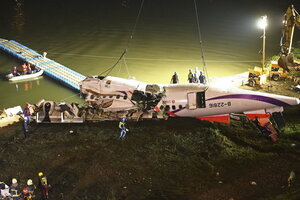The TransAsia crash and the rise of dashcam journalism
Designed to protect drivers from abuse, dashboard cameras sometimes wind up recording major news events.

The mangled fuselage of a TransAsia Airways commercial plane is dragged to the river bank after it crashed in Taipei, Taiwan, Wednesday, Feb. 4, 2015. The Taiwanese commercial flight with 58 people aboard clipped a bridge shortly after takeoff and crashed into a river in the island's capital of Taipei on Wednesday morning.
AP
The dramatic footage of the TransAsia plane that crashed into a river in Taiwan on Wednesday comes to us via a device aimed to protect the rights of drivers: a dashboard video camera.
The video begins with the plane flying, much too low, over a city, suddenly rolling to the left and plummeting to the ground. Its left wing smashes into the highway barrier and the fuselage plunges into a river, sending debris everywhere, all to the shock and horror of the driver and passenger in the car. Investigators later determined that the crash killed 23 people.
This is not the first time that the growing fleet of dashcam-equipped cars have captured the news.
The trend first came to light in February 2013, when the largest meteor to enter Earth’s atmosphere in 100 years streaked across Russian skies, exploding over Chelyabinsk. Dozens of dashcams captured the moment, which was viewed by millions.
In 2012, dashcams captured footage of another plane crash, this time in Moscow. Over the years, the cameras have also generated endless footage of car crashes, apparent scams by pedestrians and drivers alike, and police cruelty, which goes a long way toward explaining why so many Russians have dashcams in the first place.
The combination of the negligent and corrupt Russian Highway Patrol officers, accident happy drivers, and the sheer size of the country makes them necessary for motorists protection, says former Russian citizen Marina Galperina in an article for Animal.
According to the World Health Organization, for every 100,000 people, Russia has 18.6 fatal car accidents. The US, which has six times more cars, has 11.4 per 100,000. Video footage, say dashcam proponents, is the only way to protect yourself in a Russian court.
“You can get into your car without your pants on, but never get into a car without a dash cam,” Aleksei Dozorov, a motorists’ rights activist in Russia told Radio Free Europe.
But the TransAsia plane crash occurred in Taiwan, not Russia.
Dashcams are rare outside of Russia. Some countries, including Germany, Austria, and Switzerland, have gone as far as to ban dashcams, calling them an invasion of privacy. Many other countries allow dashcams but prohibit recording audio.
Dashcams serve as legal protection for drivers, but this particular footage has also serves as yet another wake-up call for airlines.
After several high profile airline crashes in 2014 in Asia – including 54 killed in a TransAsia crash in Taiwan in June – some industry experts say that it is time to overhaul the airplane safety standards. While the number of fatalities in airline crashes rose in 2014, the number of airline crashes was down – and by that measure 2014 was the safest year ever, according to the Airline Safety Network:
Over the year 2014 the Aviation Safety Network recorded a total of 21 fatal airliner accidents, resulting in 990 fatalities. This makes 2014 the safest year ever by number of fatal accidents and the 24th safest year ever in terms of fatalities. Most accidents involved cargo flights (10) and passenger flights (8). Given the expected worldwide air traffic of 33,000,000 flights, the accident rate is 1 fatal passenger flight accident per 4,125,000 flights.
ASN President Harro Ranter says: “Since 1997 the average number of airliner accidents has shown a steady and persistent decline..."
[Editor's note: The original story incorrectly characterized 2014 as having an alarming air safety record.]

